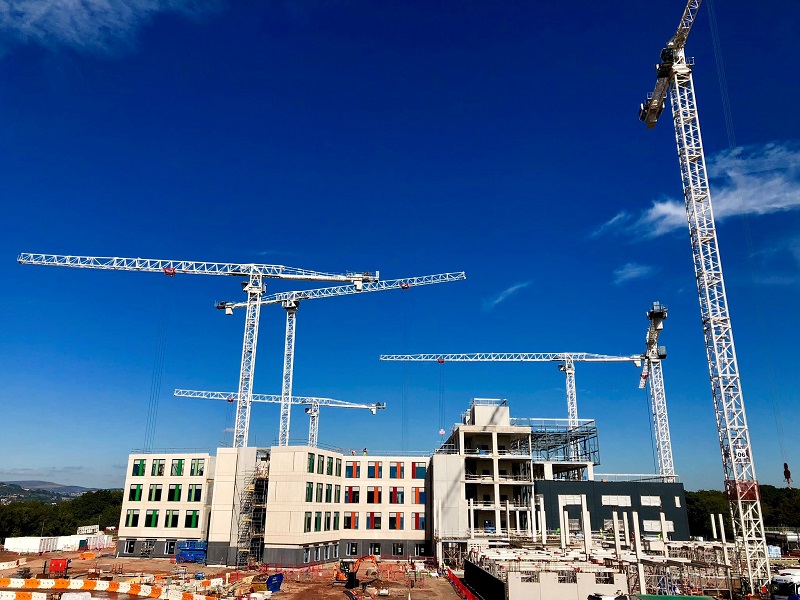Two ground-breaking new projects are helping to change the face of healthcare architecture, featuring the most-ambitious designs to date for seamless emergency care.
Healthcare specialist architect, BDP, has recently completed a new emergency assessment centre at Wexham Park Hospital in Slough, Berkshire; and is mid-way through a £193.5m project to develop the new Grange University Hospital in Wales.
Both projects aim to deliver an entirely-new approach to the design of emergency services which puts the patient pathway at the heart and brings all services – assessment and diagnostics through to treatment – under one roof.
In terms of future models of care, and the direction of healthcare design, we can see this approach being a key focus
Speaking to BBH, Nick Fairham, architect director at BDP in Bristol, said: “In terms of future models of care, and the direction of healthcare design, we can see this approach being a key focus. “It is a major step change and one that is enabling better care for patients and greater efficiency in delivering emergency care.”
The Wexham Park project was delivered under the ProCure21+ framework in partnership with construction giant, Kier.
It was part of a wider commission by Frimley Health NHS Foundation Trust to redevelop two hospital sites – Heatherwood and Wexham Park – and includes the four-storey emergency assessment centre, which brings A&E services, 24-hour assessments, and short-stay medical and surgical care together under one roof for the first time.
This will increase collaboration between clinical teams so that patients can be assessed, diagnosed. and treated better and faster, and many won’t have to be admitted to the main hospital at all.
The £49m scheme also helped to address backlog maintenance by providing additional bed capacity.
“The original department was part of the single-storey existing estate which had grown over the years in a ‘pancake effect’, impacting greatly on travel times for both staff and patients,” said Fairham.
“The trust itself carried out extensive research on the accommodation it already had and how it was being used, as well as looking at optimal patient flows.”
Working with BDP, staff then explored how the new buildings could deliver these aims.
Fairham explains: “Architects talk about form following function and flow, and nowhere is this more important than in healthcare, and particularly in accident and emergency.
“We looked at a lot of available research, including issues around designing A&E departments to reduce incidents of violence and aggression and, in understanding patient flow; it became apparent that, from arrival at the department, patients needed to feel as if they were progressing.
We looked at a lot of available research, including issues around designing A&E departments to reduce incidents of violence and aggression and, in understanding patient flow; it became apparent that, from arrival at the department, patients needed to feel as if they were progressing
“Traditionally, patients come through the entrance to a reception and waiting area. They are then called into triage or assessment and then go back to the same waiting area in between.
“One of the step changes with Wexham Park was the decision to put the waiting area in the centre of the building.
“New patient pathways have been developed to make care more efficient and allow patients to be cared for more quickly in the right place. For example, patients may be brought directly to assessment areas via a GP without going to A&E or be given necessary tests and medication during the day so they can safely return home for the night.
“This project also aimed to bring all adjacencies and modalities together so transfer and walking times were reduced dramatically.
“Under one roof, patients are now assessed and move through to diagnostics, treatment and inpatient areas much more quickly.
“This means once they leave the main waiting area they do not return, helping them to feel like they are making progress and reducing the usual frustrations.”
The four-storey new-build development now links directly to the existing hospital, with an ambulance bay seamlessly connected to the resuscitation area.
The emergency department itself is located alongside short-stay medical and surgical units on the emergency centre’s second floor.
The 34-bed medical unit cares for patients who are likely to be ready to go home within 72 hours, while patients on the 16-bed surgical unit may be expected to be in hospital for up to 96 hours.
A range of 24-hour services on the first floor, include an acute assessment unit (AAU) with 26 beds and eight assessment trolleys.
This sits alongside the 20-cubicle ambulatory emergency care unit where patients can be assessed, diagnosed and treated without being admitted overnight.
By more-swiftly assessing patients in this way, overnight admissions can be dramatically reduced.
Furthermore, the paediatrics and minors A&E is closer to the main entrance for enhanced outcomes.
In accident and emergency units fast decision-making and timing are critical, so it is an obvious choice that this is where this new design approach is being seen initially
“We consulted extensively with staff on this project, using virtual reality imaging and physical mock-up rooms so they could ‘walk around’ the building during the design phase,” said Fairham.
Standardising rooms is also helping to futureproof the building, with areas able to be expanded or contracted in response to demand or staffing levels.
Fairham said: “Universal assessment areas were all designed to exactly the same footprint to be acuity adaptable - so the patient is cared for in the same room which can adapt to suit their clinical needs.
“And the inpatient beds on the upper two storeys, with the outboard placement of en-suites in single patient bedrooms improving observation.”
Within several of the assessment and treatment spaces, chairs rather than beds are used, giving patients who do not need to lie down the impression they are nearer to discharge, as well as offering space efficiency.
“It’s a very psychological approach,” said Fairham. “Often if you are put into a bed you feel your condition warrants that and might be more serious. If you are able to sit in a chair you feel much more positive and as if you are progressing.
“This progression was the centrepiece of the design.”
The team’s second project also uses this more-joined-up, patient-centric approach.
Previously known as the Specialist and Critical Care Centre; the Grange University Hospital is the centrepiece of a new model of healthcare delivery serving over 600,000 people needing complex emergency or critical care.
It will have 471 beds and will be home to more than 40 specialist services, with a helicopter pad for patients who arrive by air ambulance.
Once again, careful modelling of staff and patient flows was carried out, enabling early streaming, and this is supported by dedicated circulation systems for front-of-house and back-of-house services, enhancing patient privacy.
The design also takes advantage of the landscaped setting, offering views across the surrounding countryside and access to therapeutic spaces to promote healing and wellness.
And the workplace offers a highly-connected environment with high-quality staff spaces to attract and retain the best workforce.
Fairham said: “This project is about centralising two sites and ensuring that assessment, diagnostics and treatment are all within easy reach.”
He concluded: “In accident and emergency units fast decision-making and timing are critical, so it is an obvious choice that this is where this new design approach is being seen initially.
“But, having worked on these two projects, there are definitely lessons to be learned and I can see it undoubtedly being used much more widely in healthcare.”

Work is well underway at The Grange

